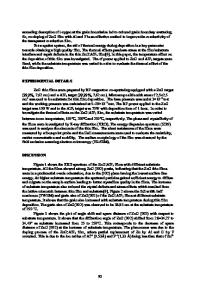Lattice Disordering, Phase Transition, and Substrate Temperature Effects in MeV-ION-Implanted III-V Compound Semiconduct
- PDF / 459,582 Bytes
- 6 Pages / 420.48 x 639 pts Page_size
- 78 Downloads / 294 Views
LATTICE DISORDERING, PHASE TRANSITION, AND SUBSTRATE TEMPERATURE EFFECTS IN MeV-ION-IMPLANTED III-V COMPOUND SEMICONDUCTORS Fulin Xiong*, C. J. Tsait, T. Vreeland Jr.t, and T. A. Tombrellot *Gordon McKay Laboratory of Applied Science, Harvard University, Cambridge, MA 02138 "tCalifomiaInstitute of Technology, Pasadena, CA 91125 ABSTRACT An experimental study of lattice disordering, the crystalline-to-amorphous (c-a) phase transition, and substrate temperature effects in MeV-ion-implanted III-V compound semiconductor crystals is presented. A comparison has been made between the GaAs and lnP systems, which have been implanted with 2 MeV oxygen ions at either room temperature (RT) or near liquid nitrogen temperature (LT). A strong in situ dynamic annealing has been found in the RT implanted GaAs, and the LT implanted GaAs exhibits heterogeneous (at the end-of-range of the ions) and homogeneous (at the subsurface region) c-a phase transitions. In InP crystals, in situ annealing is much less pronounced in RT implantation, and dose-dependent damage nucleation and layer-by-layer amorphization take place. LT implantation results in lattice disordering and phase transition with a critical dose at least one order lower than that for GaAs. The mechanisms and kinetics of lattice disordering by ion irradiation are also discussed. INTRODUCTION MeV ion implantation into III-V compound semiconductors has attracted considerable attention in recent years due to its application potential for modifying deeply buried layers and for fabricating 3-dimensional devices[?,2]. An understanding of the mechanisms for lattice disordering and its associated physical phenomena during MeV ion implantation is of technological importance and scientific interest. With respect to the ionsolid interaction, extension of the ion energy to the MeV range provides many advantages (such as deep implantation and minimized surface damage), but it also leads the ion-solid interaction into a new regime where many associated effects need to be understood. In the material aspects, differing from the damage processes in single elemental semiconductors, defect generation under ion implantation in compound semiconductors is rather complicated due to their binary nature and defect complexity. In addition, the conditions for implantation, such as the substrate temperature and the ion beam flux density are also important in determining the final state of the damage profile and the dopant distribution. In this paper, an experimental study of lattice disordering, the crystalline-toamorphous (c-a) phase transition, and substrate temperature effects in 2MeV-oxygen-ionimplanted III-V compound semiconductor crystals is presented. A comparison has been made between the GaAs and InP systems with the substrates at either room temperature or near liquid nitrogen temperature. The results have revealed marked differences in terms of lattice disordering, lattice strain profiling, and threshold doses for the c-a transition in two materials as well as temperature influence. Mechanisms
Data Loading...











